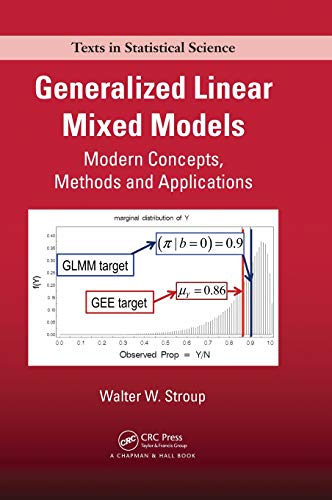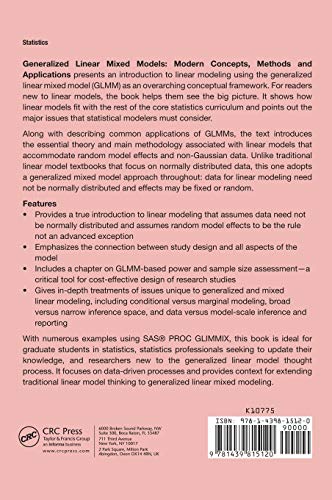Servicios al cliente
Sobre nosotros
Copyright © 2025 Desertcart Holdings Limited
Desert Online General Trading LLC
Dubai, United Arab Emirates




Generalized Linear Mixed Models: Modern Concepts, Methods and Applications (Chapman & Hall/CRC Texts in Statistical Science)
C**H
Explains the relationship between study design and analysis
I'm still working my way through the text but I give it a high recommendation. This is one of the first texts I've found to give a step by step description about matching study design with analysis plan. I appreciate the clear explanations and concrete examples. I lack an extensive preparation in statistics so there are some things I need to look up as I'm reading, but I appreciate the clear explanations of analyses with data that are not normally distributed. I also appreciate the periodic translation of terminology from other fields into what they're talking about (i.e. hierarchical linear modeling and social science). Thank you for making a challenging topic a bit easier to understand!
P**A
Outstanding, and not just for SAS users
I am an R user, and resisted buying a book on GLMMs with examples in SAS. But I heard about this book on R's mixed model mailing list (no less than Doug Bates gave it a plug). I decided to give it a read - boy was I surprised! This book has helped me to understand GLMMs like no other.Here's what's good:1. The book starts with the view that linear regression is a special case of GLMM, and builds a simple, clear, and solid exposition from this assumption. The author's case is persuasive; I think students (and others) coming at *regression* for the first time will benefit from this approach.2. The first part of the book (esp. chapters 2) develops GLMM in the context of experimental design, with application's to "nature's experiments" -- ecology, longitudinal designs, panel data, etc. The focus on developing a good and appropriate linear predictor with a clear appreciation of the peculiarities of each specific design has strongly improved my understanding of GLMMs (and more basically of *regression*). I especially appreciated Stroup's advice on sketching a plot plan for each design. There's also a plain and persuasive argument on the importance of distinguishing between units of observation and units of replication/randomization when constructing any regression model.3. The text is written cleanly. Few words are wasted. Stroup's dry sense of humor makes the book a pleasure to read, and fun! No BS. You get the feeling you'd like this guy.4. Even the SAS parts were helpful (hence the surprise!) This is because Stroup works through the issues of how the computations are performed in light of the specificities of a model. Again his point is that you need to understand how to construct a good and appropriate linear predictor. No receipts for that. Oddly then, I think the SAS parts are worth reading and understanding regardless of whatever platform you use.Drawbacks:1. As a newbie to GLMM, I found I had to re-read some parts, and I feel I could use another read through it. Those who are coming at GLMMs for the first time should expect to move slowly. Those who understand GLMMs (or think they do) but are not used to concentrating carefully about design questions, will also want to move slowly. No canned solutions.
W**K
A LOT of mistakes/ typos, but still helpful
I purchased this book based on the positive reviews I read online, and I agree that this can be a very helpful stats and SAS textbook, but it lost points due to an abundance of errors and typos. Also, this is a very dense textbook, so it can be tricky if attempting to work through it on your own (rather than guided through it as part of a stats course).It is still very helpful in describing the theory behind the model formation and selection. And I really like that the example SAS codes he uses in the book are available to download (for free) from the publishers website (http://www.crcpress.com/product/isbn/9781439815120).The reason I'm only giving it 3/5 stars is because of how many mistakes and types are in the textbook (and in the SAS code available online, which as of now was last updated Oct 22, 2012), both which can seriously impair understanding and take a while to recognize/fix.Some key examples are:1) The data and output data set names give in the "Chapter_1_Table_1_1" SAS example file are incorrect. The code doesn't work as written; you have to fix the names for it to run correctly.2) The SAS code provided for Example 3.5 (using data set 3.2) does not include the variables a or b. These need to be reconstructed based on the table at the bottom of page 85. However, following the outline of the table, the SAS output results for a and b are backwards. So to get the correct output as given in the book, the treatments need to be as follows: treatment 0 = A0, B0; treatment 1 = A0, B1; treatment 2 = A1, B0; treatment 3 = A1, B1These examples don't include the many typos in the actual text.Also, since I wasn't as familiar with matrix algebra, I had to look online for a lot of help and clarification, especially early on.But since this is forcing me to brush up on basic stats knowledge, as well as helping me understand more advanced concepts, I'm still giving it a conditional recommendation.
A**W
Extremely well written
This book is thoughtfully laid out and is very readable. There are several nuggets in this book that I haven't found in any other mixed models texts. I enjoyed the discussions throughout the text of computational issues related to GLMMs. The book pairs nicely with Demidenko's Mixed Models.
G**U
From Basics to Informed Expert
I bought this book to become better acquainted with Generalized Linear Models. I got more than I even expected. A new vision of statistics, tempered by theory, equations, and meaning of each step one takes throughout his or her analysis. This book is a must have for those teaching or considering teaching statistics. The taxonomic presentation of kinds of models is both compelling and easy to grasp. It is also pivotal for those using statistics and applying advanced modeling.
K**G
perfect condition.
Brand new, perfect condition.
S**I
Not a moment of glory for didactics
The book is a honorable essay to begin the statistical instruction at the right end: Not with the so called "General Linear Model" which is then extended to the "Generalized Linear Mixed Model", but with the latter itself. Unfortunately the author misses an important point: A picture is worth a thousand words. With a certain nonchalance he glides over concepts which are really hard to grasp and this without illustrations: Not a moment of glory for didactics.
C**G
bien mais aurait pu faire mieux
Ouvrage abordant un sujet technique et pointu avec une relative efficacitéJ'ai apprécié les 6 premiers chapitres qui posent les bases et montent en puissance progressivementLa suite de l'ouvrage est normalement consacrée aux applications des GLMM mais on regrettera l'absence d'étude de cas avec interpretation concrète des sorties logiciellesDommage aussi que l'auteur ne soit pas favorable a R (on ne trouvera aucun code R dans tout l'ouvrage)Le code SAS est quant a lui omniprésent avec souvent très peu d'explications sur la syntaxe utilisée...A conseiller malgré tout avec des bases solides en calculs matriciels
Trustpilot
Hace 2 semanas
Hace 1 semana